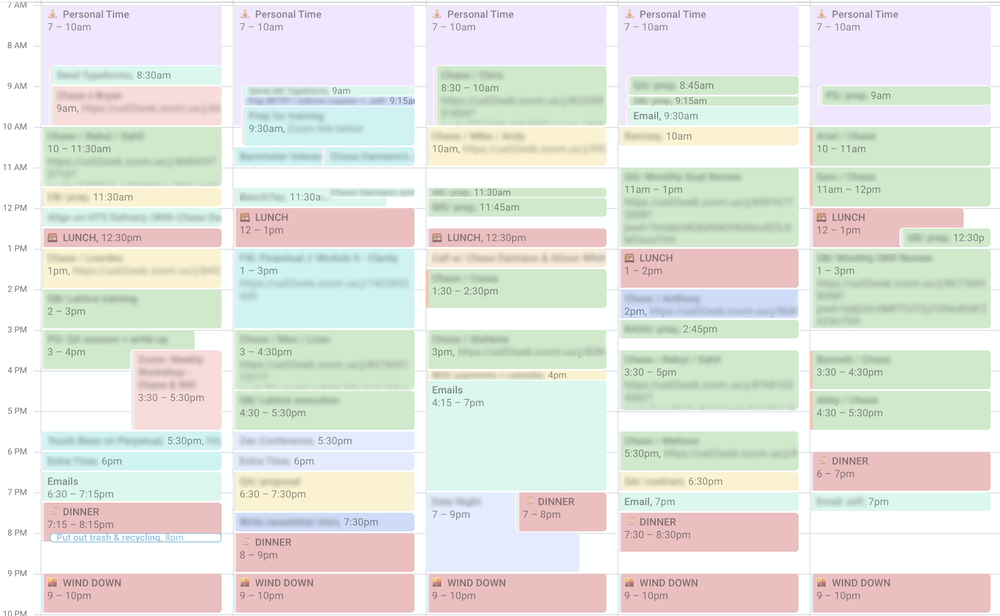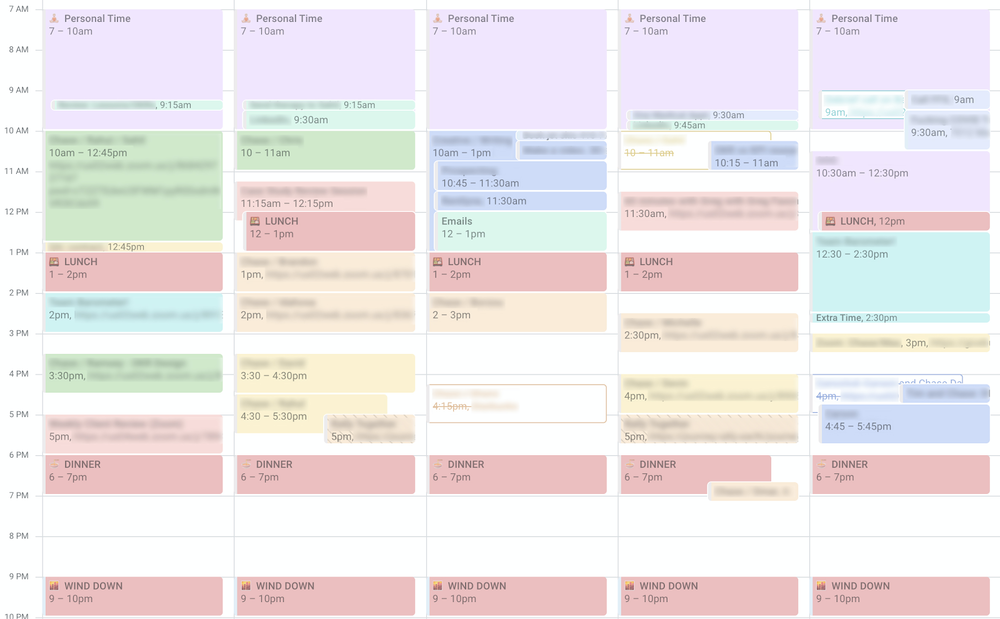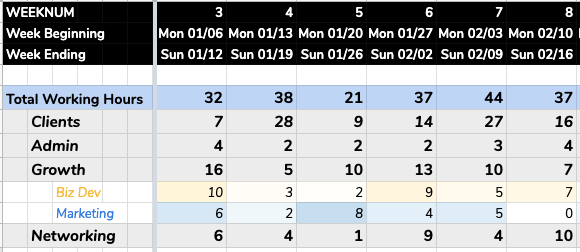In startup life, time is typically the biggest limiting factor on what we can accomplish both professionally and personally. Between all the meetings, strategy sessions, ideation, problem-solving, administrative tasks, and constant analysis of what is and is not working—not to mention things like taking care of your kids, getting dinner on the table, and spending quality time with partners, friends, and loved ones—it almost always feels like we never have enough time to go around. Needless to say, that feeling creates a major source of stress, which further infringes your ability to make the most of the time you do have. Because of that, finding more effective ways to manage your time is one of the greatest gifts you can give both your startup and yourself.
I realized this long after I was already in the throes of an unhealthy relationship with work and, thus, with time. I was spending all of my time working (often, more inefficiently than I could have) and worrying about work, and not enough time actually focused on the task at hand or the people I was with. So, I set out to change it. In the process, I also changed my understanding of my calendar, my attention, and my overall goals.
For nearly everyone, managing time effectively accomplishes the following key things:
- We become more aware of what we’re actually working on. “Where does all my time go?”
- We work on the right things. “What do I need to do to achieve my goals?”
- We learn how to favor effectiveness over productivity. “Work smarter, not harder.”
In this article I share the strategies that have worked for me to help optimize how I think about and spend my time as well as the feedback loop therein. I hope these ideas will also help you get the most out of our most precious resource.
Core principles
For each of us, the ways we use our time, how we value it, and the management ideas and tools that work best for us differ. Over the years, I have identified the following core principles as the truest and most important foundation for my personal philosophy on time management:
- All effort, in any form, takes time.
- The calendar is the single source of truth for use of time.
- A “to-do list” is simply a list of activities not yet to be scheduled on a calendar (again, because all effort takes time).
- I am a better mono-tasker than a multi-tasker—one thing at a time.
- Awareness can be built through data.
- Achieving goals is about being intentional. Being intentional is about planning ahead.
- Whatever the framework, don’t be overly rigid.
Following these principles, I use a system of “time-boxing,” planning, monotasking, and calendar analysis—all working together—to plan my days and weeks.
Time-boxing in practice
Time-boxing is the practice of allocating all of your activities—efforts, meetings, appointments, and even “free” or personal time—into fixed periods, as “boxes,” on your calendar. By visually rendering all of your time spent in this way, you can gain a much better awareness of where your time is going, both before and after the present moment. Now, there are dozens and dozens of articles about time-boxing, detailing various methods, but these are the methods that work best for me.
A few key rules to follow when time-boxing:
All effort is on the calendar. Every project, task, and to-do—any form of effort—is best represented on a calendar. While this may look different for everyone, everything on my to-do list worth more than 15 minutes is placed on my calendar, in order to keep conflicts to a bare minimum. I’ll never be on a Zoom call AND working on something. It’s one or the other.
A few large blocks are better than many small blocks. The details aren’t important. It doesn’t matter if I put the name of the specific task on the calendar. I use labels like “To-Dos” and “Emails,” instead of “Book an appointment with Verizon” or “Answer 10 emails from this week.”
Back-adjust the calendar to capture what actually happened. I also retroactively adjust my calendar to represent the truth. Most of my late-stage biz dev calls, for example, last longer than the allocated time slot on our calendars. When the meeting is over, I update the meeting invite to capture the full time (or add a second block of time, so other meeting attendees don’t get weirded out).
Nothing is a hard and fast rule. I won’t beat myself up for not following my own schedule. The idea is to capture the TRUTH in the schedule. It’s more useful to stay in flow, keep it light, and fluidly move things around as conditions throughout the day or week change.
Assess changes with discretion. Often, a new opportunity appears in conflict with what you’ve planned. That’s okay. But now, instead of unconsciously and automatically saying “yes,” know that it comes at a cost—namely, what you previously planned for. Accepting or rejecting the last-minute request is fine. If you accept, simply move the time block you originally planned (if it is still important) to another time. If it’s no longer important, delete it and move on.
Use visuals wherever possible. I color-code all my time box entries to understand, at a glance, where my time is going. Each color has a meaning, which helps render a macro-view of how the time is spent in a week.
My Monday-to-Friday calendar
As you can see below, the net effect of the above time-boxing principles is a “busy-looking” (and colorful) calendar. That’s okay. It accurately shows my daily and weekly motions, what my intentions are, and what’s happening in my life. You have these motions too – this is just about making them visible. Here a couple examples of what my Monday-to-Friday calendar can look like:
Busy week

Calm week

Your own color codes will be specific to your life and business. Here’s what I use:
Work time blocks
- Green = Client Meetings. These are phone calls or video calls with clients.
- Orange = Networking. Any professional meeting that could lead anywhere: it could be a peer, mentor, or new business opportunity.
- Yellow = Leads. These are active leads that may close in new business.
- Blue = Growth. These include marketing, branding, content development, website updates—anything centered around my broader message.
Personal time blocks
- Purple = Personal Time. Time I (mostly) spend alone. Includes meditation, breakfast, exercise, and open time to do anything. I tend to avoid meetings before 10am when possible, and this purple block on the calendar reminds me of that daily.
- Light Blue = Family & Friends. Here, I (used to) pick up my son every day at 5:30pm. That’s also my signal to stop work. Note that most evenings I have white space. This is a lot of family time, but I typically don’t put it on the calendar in order to avoid being over-prescriptive.
- Red = Meals. With working remotely, I have a distinct opportunity to sync my lunch and dinners with both my partner and son this year, based on their work and school schedules. Blocking this off on the calendar reminds me not to fill the time with something else and miss out on our shared meals.
Special time blocks
- Gray = A time marker. This for events or reminders that don’t inherently take up any time, but that I should to be aware of. For example, reminders for when my son is flying on a plane, or space-saver blocks to avoid scheduling meetings.
Analyze your time data
In the early days, every week, for working hours only, I’ll review how I spent my time in the previous week. I count up the hours and add them to a spreadsheet organized by work category. Then, I’ll project forward how I’ll spend my time the following week. The idea is: Where you focus your time is what inevitably happens. For example, if I want to increase revenue, well, then I better be scheduling some sales conversations on my calendar! The right inputs beget the right business results. And as I’ve gotten more comfortable with my weekly rhythms, I’ve shifted this analysis to monthly.

Through the data above (which is from early 2020, when my business was just getting off the ground—things have changed a lot since then), you can see some “sprints” with my clients in specific weeks. You can also see relative consistency in my Growth/Biz Dev/Marketing and Admin efforts.
Such data is also useful for understanding opportunities to outsource or hire. For instance, if Admin time were to increase too much as a percentage of time worked, it would signal that perhaps it’s time to hire an executive assistant. Or were Marketing to increase beyond my capacity, maybe it’d be time to work with a marketing firm. Of course despite all of this, some things stay with me—like working with clients. But as a result of my time analytics, each of these decisions becomes a conscious one.
Intentionality, not severity
I think it’s worth repeating that this system isn’t meant to be set in stone and ruled with an iron fist (yours or anyone else’s). I often “fail” at my own system. For instance, meals are nearly always cut to 30 minutes, and sometimes I miss them entirely. I often have meetings before my goal start time of 10 AM, and I am rather inconsistent with my “shut down” time, because it feels like stopping a freight train in motion to simply turn off because my calendar tells me to.
I know many entrepreneurs who think, Such rigidity will never work for me. And clearly, it doesn’t always work. But the point isn’t to be rigid or create so much structure that it goes against your natural flow. The point is to be intentional.
The main challenge I see with entrepreneurs is when they have no system at all. Many equate entrepreneurship with having no system, no routine—just pure freedom to do anything you want however you want. What it really means is that you simply don’t have the safety of a standard corporate system to provide you with structure, so you have to create that structure for yourself.
Time: Life itself
Effective knowledge workers, in my observation, do not start with their tasks. They start with their time.
Peter Drucker
At the end of the day, time is really all we have. It’s the same for all humans, across all nationalities, creeds, and demographics—none of us know how much time we have before we leave this earth. Further, our use of time is the very essence of how we live our life itself—so understanding how to use your time effectively is one of the best things you can do to engage with your life in ways that will make you most present and, ultimately, happiest.
Further reading…
Curious to learn more about time-boxing and other tools for and reasoning behind time management? Check out the articles and books below:
- “Peter Drucker on How to (Actually) Manage Your Time” by Charles Chu, Observer
- “What Makes an Effective Executive” by Peter F. Drucker, Harvard Business Review
- The Effective Executive: The Definitive Guide to Getting the Right Things Done by Peter F. Drucker
Love what you’re reading? Subscribe to our newsletter and never miss out on our latest posts.







